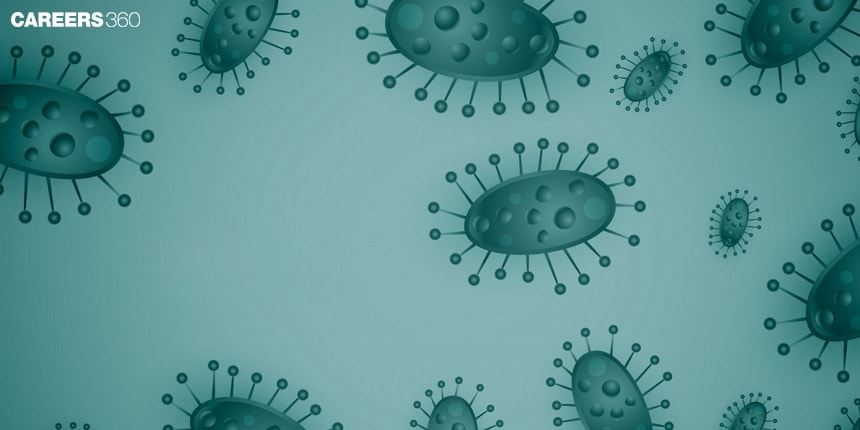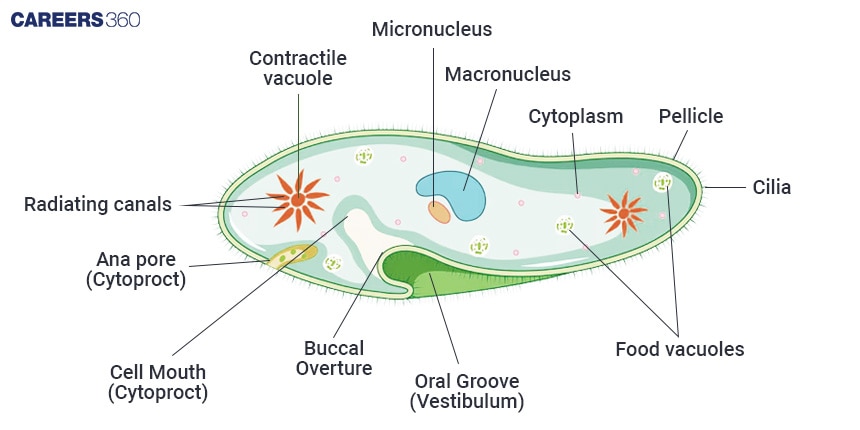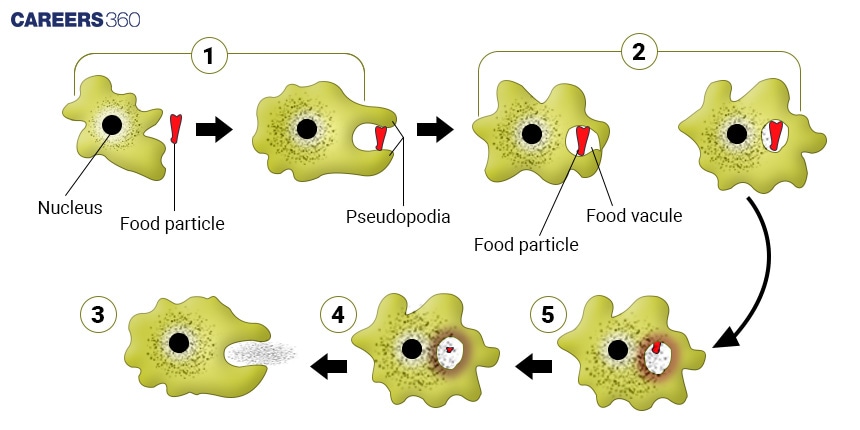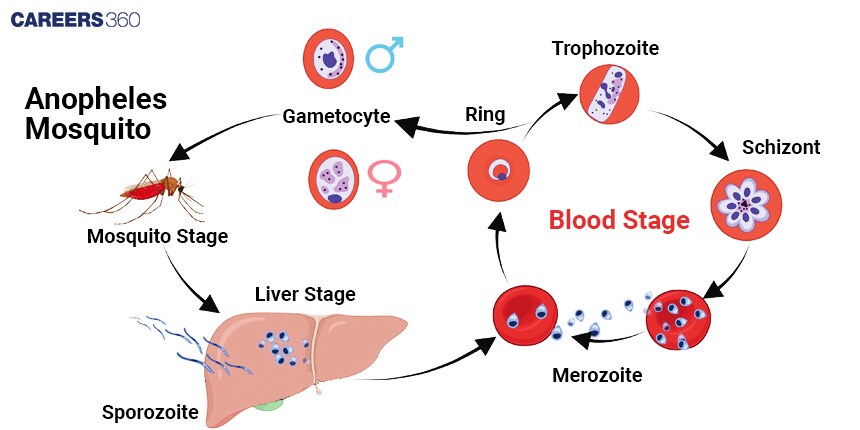Protozoa: Structure, Classification, Growth, Development, Characteristics
What Is Protozoa?
Protozoa is a broad class of microorganisms that are of great importance in the biosphere both on land and in water. These microorganisms possess movement organelles such as cilia, flagella or pseudopodia and have diverse criteria of nutrition and they are predators, parasites or symbiotes. Thus, a further focus on protozoa is essential due to their services as decomposers and primary consumer organisms involved in the cycling of nutrients and setting of trophic chains or webs.
Don't Miss: Most scoring concepts for NEET | NEET papers with solutions
NEET 2025: Syllabus | PYQs | Crack NEET in 2 months - Study Plan
NEET Important PYQ & Solutions: Physics | Chemistry | Biology | NEET PYQ's (2015-24)

Furthermore, protozoa are also recognised to be largely pathogenic, they cause diseases such as malaria and giardiasis in man and are also used as model organisms for studying cell and disease mechanisms in biomedicine. Protozoa include a variety of different parasites with different life cycles and consequent evolutionary characteristics; this makes them interesting objects to ecological and medical now, as well as to evolutionary research.
Structure Of Protozoa
The structure of Protozoa are listed below-
Cell Structure
The first layer to be described is outlined by the cell membrane or plasma membrane which enshrouds the protozoan cell and acts as a barrier that controls the passage of material to and from the cell.
Cytoplasm occupies the inner space of the cell, it is full of various structures floating in the gel-like substance called cytosol.
They give an ancora to cellular structures and also act as a base for metabolic activities to occur.
One of the main characteristics of protozoa is the presence of a definite nuclear area containing the hereditary material of the cell, DNA.
The nucleus controls the cellular action and it harbours chromosom which has a filamentous structure known as chromatin.
Organelles
Protozoan cells contain specialized organelles that perform specific functions:
Mitochondria:
Structures involved in the oxidative processes and cellular food and energy processing through oxygen.
Endoplasmic Reticulum (ER):
They are involved in protein and lipid synthesis and transportation in the cell organelle.
Golgi Apparatus:
Retrieves remodels, and packages proteins and lipids for transport or delivery to the other organelles.
Vacuoles:
Small sacs filled with food, water or waste products that have been transported to their destination.
Contractile Vacuole:
It is identified in some especially freshwater protozoa, it also regulates the balance of water and removes excess water from the cell.
Diagram Of A Typical Protozoan Cell

Characteristics Of Protozoa
The following are the characteristics of Protozoa:-
Locomotion
Protozoa exhibit diverse mechanisms of locomotion, allowing them to move efficiently through various environments:
Pseudopodia
Amoeba like protozoa or others moves with the help of pseudopodia, which is a protrusion of cytoplasm only.
They use and pull back pseudopodia to move on surfaces and capture their food.
Flagella
Trypanosoma and Euglena move through one or several whip-like flagella also called undulating membranes.
Flagella are supplied with the movement in a coordinated way to drive the organism through liquid mediums.
Cilia
Some of the protozoa with locomotion organelles include Paramecium and Stentor; they use numerous short processes known as cilia.
Hair-like structures called cilia form in rows, thus making this organism have movement and swim in water through bending.
Gliding
Plasmodium, which is a malaria parasite; these creatures exhibits locomotion through gliding on structures or mechanisms.
Sailing motion enables organisms to manoeuvre their surroundings well.
Nutrition
Protozoa exhibit various modes of nutrition to obtain energy and nutrients from their environment:
Holozoic
Most protozoa feed holozoically, they, therefore, take in whole food through a process called phagocytosis or phagocytosis.
For instance, some single-celled organisms such as amoebas, namely Amoeba, engulf their prey or efficiently engulf organic material through perhaps their pseudopodia.
Saprozoic
Saprozoic protozoa are those that feed by surface collection by trapping dissolved organic matter or particulate substances.
Being detritivores, they play an essential role as decomposers and nutrient recyclers in various systems.
Parasitic
Protozoa are single-celled organisms that are parasitic and are found either on or in a host organism which derives nutrients from the host tissues or body fluids.
Examples include Plasmodium spp. , which results in malaria in humans, are normally conveyed by mosquitoes.
Mixotrophic
These are nutrition that is the combination of both heterotrophic and autotrophic, this is common with some of the protozoa.
They can make their food, from light when conditions are favourable or; they feed on other organic matter or real prey.
Process of phagocytosis illustrated with a diagram

Reproduction
Protozoa reproduce through both asexual and sexual mechanisms, adapting their reproductive strategies to environmental conditions and life cycle stages:
Asexual
Binary fission: Most of the protozoa undergo a form of asexual reproduction known as binary fission; this is where a parent cell divides directly into two daughter cells.
This process is typical for the movement of amoeboid and flagellated protozoa which guarantee rapid population growth in a comfortable environment.
Budding: Some protozoa undergo budding for example the yeast-like fungi.
From the parent cell, a small shoot or a bud is produced and just when it comes to the independence it separates itself to form a new being.
Multiple fission: In multiple fission, both the parent and the new cells are produced at the same time.
This process occurs in some parasitic free-living protozoa at the reproductive stage to ensure the production of many offspring.
Sexual Reproduction
Conjugation: The process of sexual reproduction in protozoa entails the exchange of individuals in a species.
In conjugation, two cells or two organisms become united for a while and exchange nucleation material which increases the variation of the offspring.
Conjugation is found in ciliated protozoa such as paramecium.
Life cycles of notable protozoans like Plasmodium (malaria) with diagrams

Classification Of Protozoa
Protozoa are classified into several major groups based on their morphology, locomotion, and life cycle characteristics:
Amoeboid (Sarcodina):
Locomotion and swallowing in the large group of amoeboid protozoa occur using the projections of the cytoplasm, pseudopodia.
Some of them are; Amoeba and Entamoeba histolytica which are characterised by their mode of movement which is called amoebic motion and their mode of living which is parasitic.
Flagellates (Mastigophora):
Flagellated protozoa are the ones that move through whip-like structures known as flagella which push the organisms into their respective habitats.
Some of them are Trypanosoma; which causes diseases such as sleeping sickness in human beings; and Euglena which is photosynthetic and heterotrophic.
Ciliates (Ciliophora):
Ciliated protozoa use many hair-like structures called cilia on their cell body and the cilia move in a rhythmical wave-like fashion.
Paramecium and Stentor are two familiar ciliates with many elaborate activities and foraging methods.
Sporozoans (Apicomplexa):
Sporozoans are typically parasitic protozoa with an apical complex, an organelle that plays a role in host cell penetration.
Both sexual and asexual reproduction occur in their life cycles, perhaps as a means of adaptation.
Some parasitic genera include Plasmodium causing malaria and Toxoplasma gondii causing toxoplasmosis.
Diseases Caused By Protozoa
Protozoa are responsible for several significant diseases in humans, impacting global health:
Pathogenic Protozoa
Malaria (Plasmodium spp.):
When passed on through the bite of infected Anopheles mosquitoes, Plasmodium is responsible for malaria; a severe illness that exhibits features close to flu albeit accompanied by fever and chills.
It impacts several millions of persons especially those who live in tropical and sub-tropical areas.
Amoebiasis (Entamoeba histolytica):
Entamoeba histolytica infects the large intestine and may lead to amoebic dysentery (blood stool) and liver abscesses.
People can become infected with the disease by ingesting food or water that has cysts of the parasite.
Giardiasis (Giardia lamblia):
Giardia lamblia inhabits the small intestine and leads to giardiasis that has symptoms like diarrhoea, abdominal pain and weight reduction.
It is acquired orally by consuming food, and water or manipulating mediately contaminated surfaces bearing the cystic form.
Toxoplasmosis (Toxoplasma gondii):
It primarily invades man through the ingestion of tissue cysts in raw or undercooked meat products or through the consumption of foodstuffs or water that had been contaminated with oocysts from stercoral forms in feline faeces.
These diseases are usually mild and do not manifest symptoms, however, they are fatal for the immunocompromised and cause congenital malformations if the mother contracts the diseases during pregnancy.
Preventive Measures
Preventive measures for protozoal diseases focus on key strategies to reduce transmission and infection:
Personal hygiene: Hence, washing hands with soap and avoiding the consumption of contaminated food and water are some of the ways of preventing the intake of protozoal cysts or oocysts.
Vector control: Mosquito control that involves the use of insecticide-treated bed nets, indoors, and spraying also plays a significant role in controlling mosquito & Malaria transmission.
Vaccination and prophylactic drugs: The search for more malaria vaccines goes on, although the travellers to the malaria areas take preventive drugs like chloroquine. Prophylaxis also works for such diseases as toxoplasmosis in immunocompromised patients.
Recommended video for "Protozoa"
Frequently Asked Questions (FAQs)
Protozoan is a class of monadic eukaryotic Ouotezoa that live in the water and on the land. They are relevant in ecosystems as the predators, the foods, and the recyclers of nutrients. A few protozoa are parasites leading to diseases such as malaria, amoebiasis, and other diseases in humans affecting the entire world.
Protozoa are classified based on their morphology, locomotion, and life cycle characteristics into several groups: There are five main classes of protozoa; the amoeboid protozoa (Sarcodina), flagellates (Mastigophora), ciliates (Ciliophora), sporozoans (Apicomplexa). Every group shows certain qualities and characteristics of adaptability.
Protozoa exhibit various modes of locomotion:
Pseudopodia: Some organelles have no membrane, while others have a membrane but it is not bounded; some examples of amoeboid protozoa like Amoeba move using temporary structures of cytoplasm known as pseudopodia.
Flagella: Other types of protozoa mainly the flagellated type like the Euglena move using a whip-like structure known as the flagella.
Cilia: Free-living ciliated protozoa such as Paramecium have told move with the aid of many hair-like structures known as cilia.
Gliding: A few of the protozoa have a mode of locomotion; they can slide over surfaces, which is due to the presence of certain organelles or substance secretion.
Protozoal diseases are malaria; caused by parasites belonging to Plasmodium; amoebiasis; caused by amoebas belonging to Entamoeba histolytica; giardiasis; caused by giardia lamblia; toxoplasmosis; caused by toxoplasma gondii. Measures include Personal hygiene, Vector Control like the use of insect repellent bed nets and insecticides, vaccination in case the vaccine for the particular disease is produced, and proper handling of foods, and water.
Protozoa play essential roles in ecosystem dynamics as:
Decomposers: They decompose organic material thus playing a role in cycling nutrients.
Predators: They control the size of bacteria and other microorganisms The many get rid of undesirable bacteria and other microorganisms.
Primary Consumers: These small aquatic protozoa can occupy the level of primary consumers, affecting energy flows and the stability of an ecosystem.
Also Read
30 Nov'24 12:23 PM
28 Nov'24 05:34 PM
25 Nov'24 05:18 PM
23 Nov'24 10:02 AM
22 Nov'24 01:59 PM
21 Nov'24 04:58 PM
16 Nov'24 01:58 PM